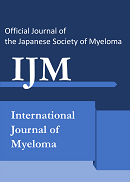Shikonin is a naphthoquinone derivative extracted from a traditional Chinese medical herb, Lithospermum erythrorhizon. It has been found to posses a variety of biological activities including strong wound healing, anti-bacterial, anti-inflammatory, and anti-tumor effects. Recently, it has been reported that shikonin induces cell death of various cancer cells. However, the mechanisms responsible for these activities remain unknown. In addition, no studies have addressed the effects of shikonin on multiple myeloma cells. In this study, we investigated the effects of shikonin on cell proliferation, cell cycle progression, and mechanism of apoptotic cell death in human multiple myeloma cells. Shikonin markedly suppressed the cellular growth of various myeloma cell lines via induction of apoptosis. Shikonin-induced cell death was in association with the loss of mitochondrial transmembrane potentials (ΔΨm), the release of cytocrome c and Smac/DIABLO. Elevation of intracellular oxygen species (ROS) production was shown during shikonin-induced cell death in myeloma cells. Shikonin markedly inhibited IL-6-induced phosphorylation of STAT3 in myeloma cells. The antioxidants, NAC, ameliorated shikonin-induced cell death and inhibition of STAT3 phosphorylation in myeloma cells. Our results indicate that shikonin induced cell death in myeloma cells, and that this was mediated through inhibition of mitochondrial damage and IL-6/STAT pathways by production of ROS.
View full abstract
